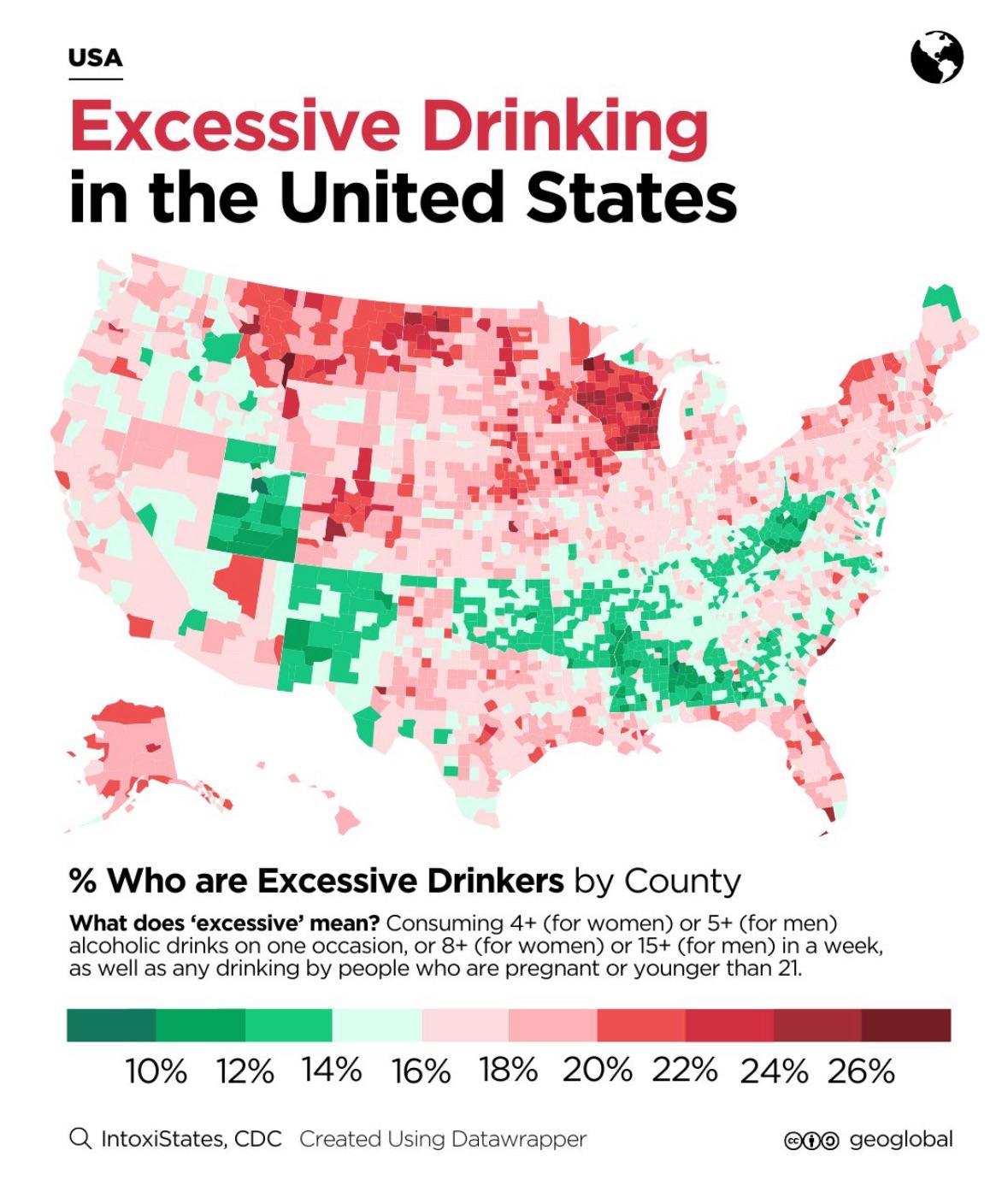Excessive Drinking in America Map


Marcus Rodriguez
Historical Geography Expert
Marcus Rodriguez specializes in historical cartography and geographic data analysis. With a background in both history and geography, he brings unique...
Geographic Analysis
What This Map Shows
The "Excessive Drinking in America" map provides a visual representation of the prevalence of excessive alcohol consumption across different states in the United States. It highlights areas where binge drinking and heavy alcohol use are most common, allowing us to discern patterns and trends in alcohol consumption.
Transitioning from the visualization, let’s delve into the broader issue of excessive drinking in America, a public health concern that affects millions and has significant social, economic, and health implications.
Deep Dive into Excessive Drinking in America
Excessive drinking, defined by the Centers for Disease Control and Prevention (CDC) as binge drinking or heavy alcohol use, poses serious risks to individuals and communities alike. Binge drinking is typically characterized by consuming four or more alcoholic drinks for women and five or more for men in a single occasion, while heavy drinking refers to eight or more drinks per week for women and 15 or more for men.
Interestingly, studies show that excessive drinking is not uniformly distributed across the United States. In fact, certain regions exhibit higher rates than others, reflecting cultural attitudes, social norms, and even economic conditions related to alcohol consumption. For instance, the Midwest and the Northeast often report higher rates of excessive drinking compared to the Southeast. This discrepancy could stem from a variety of factors, including different social environments, availability of alcohol, and public health initiatives.
The CDC reports that excessive drinking is responsible for approximately 95,000 deaths in the United States each year. This staggering number reflects the significant health risks associated with alcohol, including liver disease, cardiovascular issues, and increased likelihood of accidents or injuries. Furthermore, excessive alcohol consumption is linked to mental health disorders and can lead to devastating social consequences, such as family breakdowns and increased crime rates.
Moreover, the economic burden of excessive drinking is substantial. It is estimated that it costs the U.S. economy over $249 billion annually, primarily due to lost productivity, healthcare expenses, and law enforcement. This financial impact underlines the importance of addressing excessive drinking not only as a health issue but also as a societal challenge that requires ongoing education, prevention, and intervention efforts.
Regional Analysis
When we analyze the map of excessive drinking in America, certain states stand out. For example, states like Vermont and New Hampshire are often at the top in terms of binge drinking rates. The prevalence in these regions may be attributed to cultural factors that normalize alcohol consumption, especially in social settings.
In contrast, states such as Utah and Kentucky tend to report lower levels of excessive drinking. Utah's lower rates can largely be attributed to cultural and religious influences that discourage alcohol consumption. Meanwhile, Kentucky's lower rates may be surprising given its rich history with bourbon, but this indicates that local attitudes towards drinking can vary significantly.
Additionally, urban versus rural dynamics play a significant role. Urban areas may have more access to resources for combating excessive drinking, such as health services and educational programs, while rural areas often face challenges like fewer healthcare facilities and less awareness surrounding alcohol-related issues.
Significance and Impact
Understanding the patterns of excessive drinking in America is crucial for several reasons. First, it informs public health policies aimed at reducing alcohol-related harm. By recognizing which states and demographics are most affected, targeted interventions can be developed. For instance, states with high rates of binge drinking might benefit from stricter regulations on alcohol sales or community education programs focusing on responsible drinking.
Moreover, as awareness around mental health continues to grow, it's important to understand the link between excessive drinking and mental health disorders. Many individuals turn to alcohol as a coping mechanism, which can exacerbate existing issues and lead to a cycle of dependency. Addressing this requires a comprehensive approach that includes mental health support alongside substance abuse programs.
Looking to the future, trends suggest that excessive drinking may continue to be a pressing issue, particularly among young adults. New social habits, such as the rise of alcohol delivery services and social media's portrayal of drinking, could contribute to increased consumption. Addressing these trends proactively will be essential for improving public health outcomes and reducing the burden of alcohol-related issues in the United States.
In conclusion, the "Excessive Drinking in America" map serves as a vital tool in understanding the complexities surrounding alcohol consumption across the country. By focusing on this significant public health issue, we can work towards creating healthier communities and fostering a culture of responsible drinking.
Visualization Details
- Published
- August 26, 2025
- Views
- 82
Comments
Loading comments...